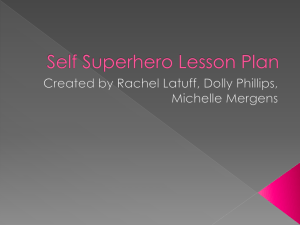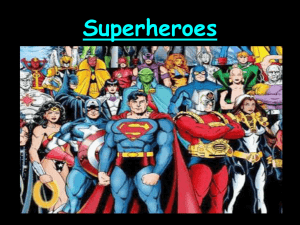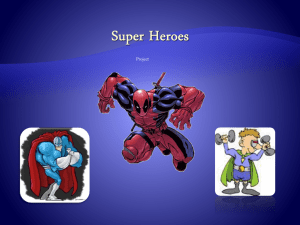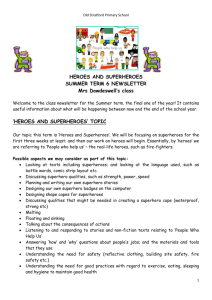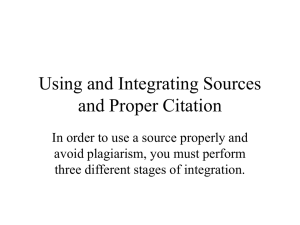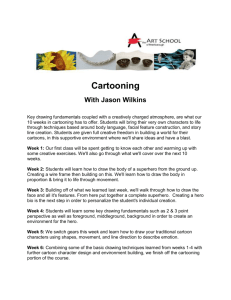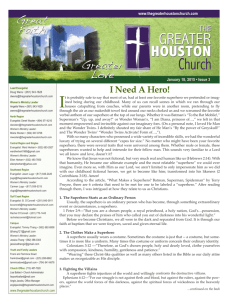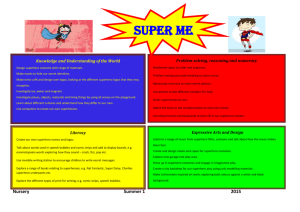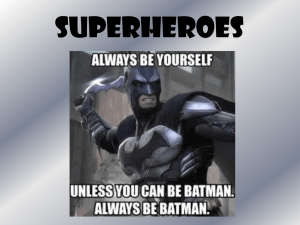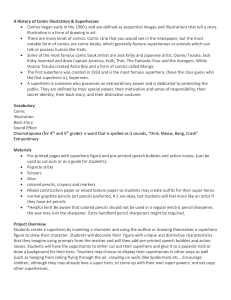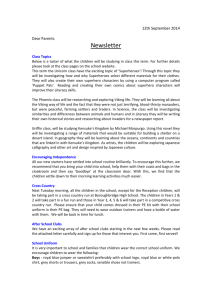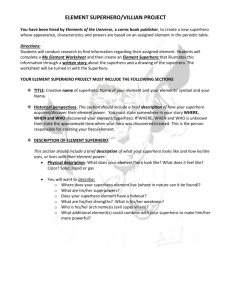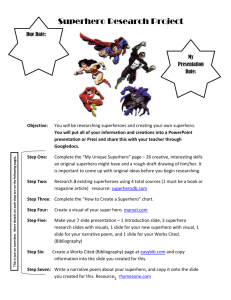Activity 1 - Languages.dk
advertisement
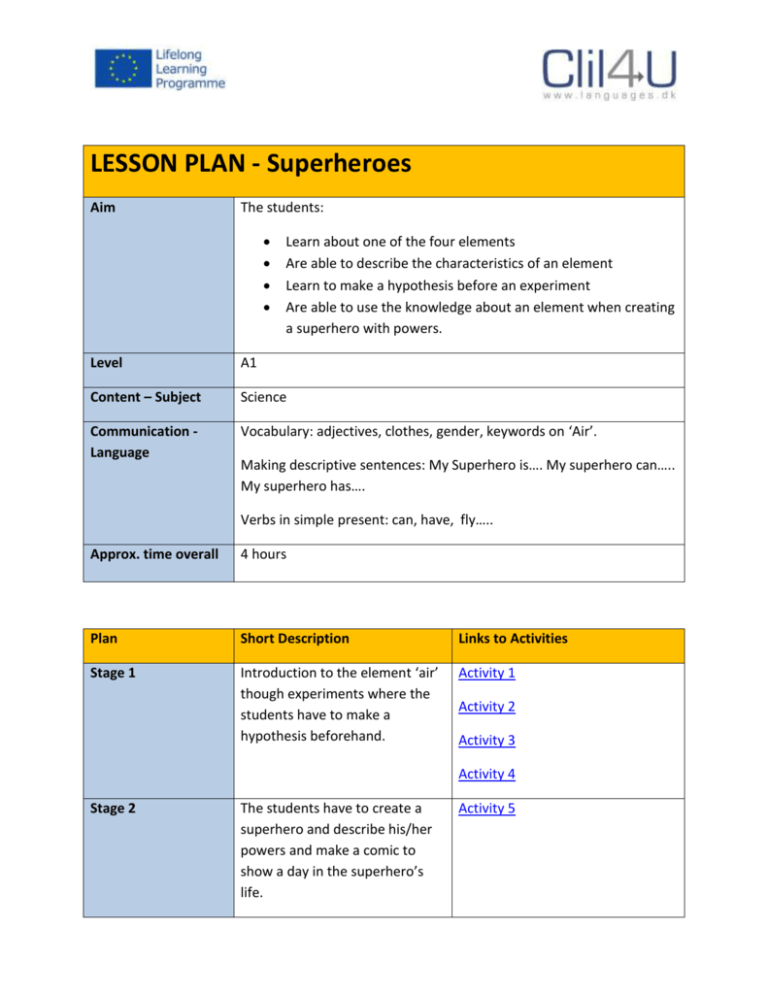
LESSON PLAN - Superheroes Aim The students: Learn about one of the four elements Are able to describe the characteristics of an element Learn to make a hypothesis before an experiment Are able to use the knowledge about an element when creating a superhero with powers. Level A1 Content – Subject Science Communication Language Vocabulary: adjectives, clothes, gender, keywords on ‘Air’. Making descriptive sentences: My Superhero is…. My superhero can….. My superhero has…. Verbs in simple present: can, have, fly….. Approx. time overall 4 hours Plan Short Description Links to Activities Stage 1 Introduction to the element ‘air’ though experiments where the students have to make a hypothesis beforehand. Activity 1 Activity 2 Activity 3 Activity 4 Stage 2 The students have to create a superhero and describe his/her powers and make a comic to show a day in the superhero’s life. Activity 5 Evaluation The students show their books with the comic to each other and if possible to another class. Activity 1 - Superheroes Procedure Introduce the class to ‘superheroes’ and to the aims for this topic. Talk about the different superheroes the students know and which powers they have eg Superman can fly and Spiderman can climb walls like a spider. They know a lot of different heroes or bad-guys with extraordinary powers. The first two experiments show movement in the air Experiment 1: Place a couple of books 10-12cm apart on a table. A piece of paper is placed as a bridge between them. What do you think is going to happen when we blow air underneath the paper bridge? (Worksheet 1) Now try it. What happened? Why? Observation: The paper sinks down Ask the class how this could be a superpower if it was something we could do (ie make things fall down) Experiment 2: Two inflated balloons are hung up so that there is a distance of 5-6cm between them. What do you think is going to happen when we blow air in between them? (Worksheet 1) Now try it. What happened? Why? Observation: The balloons move towards each other Ask the class how this could be a superpower if it was something we could do (ie get things to move towards/against each other) Approx. time 45min Level Learning outcome Indicators Materials Back to Top A1 The students Learn to make hypotheses Learn to follow instructions Learn to make observations Learn about air movement The students Use the activity sheet The students make hypotheses Can do the experiments Books Papers Balloons String Worksheet 1 Activity 2 - Superheroes Procedure Air pressure: Can air hold water? Divide the class into groups of 4 students. Explain to the groups what they are going to do with the glass and ask them: What do you think is going to happen when we turn the glass upside down? (Worksheet 2) Now try it. What happened? Why? Experiment: Fill a glass with water to the top. Put a piece of cardboard over the top. It is important that there are no air bubbles in the glass underneath the cardboard. Make sure you hold the cardboard firmly in place when you turn the glass upside down. (Do it over a sink or a tub). Now remove your fingers from the cardboard. Observation: The water doesn’t pour out of the glass. Why? Because? the cardboard is wet. The water stays in the glass because of the air pressure on the cardboard. This pressure is stronger than the pressure from the water. Ask the class how this could be a superpower if it was something we could do (eg hold back water like Moses, stop it raining where we are standing, make things stop moving towards us) Approx. time Learning outcome Indicators Materials Back to Top 20min The students Learn to make hypotheses Learn to follow instructions Learn to make observations Learn about air pressure The students Use the activity sheet Make hypotheses Can do the experiment A glass – for each group A piece of cardboard or paper – for each group Sink/tub worksheet 2 Activity 3 - Superheroes Procedure Blow a ball - game The class is divided into pairs. Each pair has a table and a piece of cotton wool or a ball made from a piece of paper. They are to battle against one another. They have to stand on each side of the table. They have to blow air against the wool/ball and they score when the wool/ball goes over the opposite edge of the table. Play for 3min. Afterwards, talk to the class about the movement of the wool/ball when we blew air against it. Which way did it move? What if both blew at the same time from different sides? How much effort did it take? Ask the class how this could be a superpower if it was something we could do (ie make things move away) Approx. time Learning outcome Indicators Materials Back to Top 15min The students: Learn to follow instructions Learn to make observations Learn that air can move things. The students: Have fun while playing Answer questions Cotton wool or paper Tables Activity 4 - Superheroes Procedure The weather - Tornadoes Air also has destructive powers, which can be seen in eg a twister or a tornado. (link to an explanation for teachers) http://youtu.be/ljHgZS2vnok) Explain to the students the air movement that creates the twister and then do the experiment with the tornado in a bottle (http://youtu.be/M9OmmqtoM_k). Through the experiment, they get an understanding of the circulation power needed for tornadoes. http://youtu.be/7KDz6dGQ5RE - Here they can see the beginning of a tornado (0.40-2.20) http://youtu.be/cj0HPni092E - here you can see animations of the different categories of tornadoes. Ask the class how this could be a superpower if it was something we could do (ie get things to fly and move heavy objects up and away) Approx. time Learning outcome Indicators Materials Back to Top 30min The students: Learn about the power in a tornado Learn how a tornado is created Learn to follow instructions The students: Can do the experiment Computer Projector Bottles Water Glitter Washing up liquid Activity 5 - Superheroes Procedure Now the students know some of the powers of the element ‘air’ and they have to use that knowledge to create powers for their superheroes. Together the class comes up with ideas of which powers are possible. They can make drawings to illustrate the powers and these drawings are hung in the classroom. The students get a book each and create their own superhero and finally they have to draw a comic about a day in the superhero’s life. Before starting on the comic, let the students tell each other about their superhero (page 2 and 3 in the booklet). You could use the method from “cooperative learning” called “Inside-outside Circle”: 1. Students stand in two concentric circles around the classroom. Students in the inside circle face out, facing a student standing on the outside circle. 2. Students from the inside circle share something with their partners. 3. Students switch roles; the outside circle students now share while their partners listen. 4. Students rotate to work with new partners – rotate two people ahead to a new partner Approx. time Learning outcome Indicators Materials Back to Top The comic: Talk with the class about characteristic of comics. Together with the students, the teacher makes suggestions about what they could write in their speech-bubbles and writes them on the board. 2 hours The students: Can use their knowledge about the element ‘air’ Learn to make a comic Speak English The students: Produce/draw illustrations that refer to the element ‘air’ Can describe their superhero in the book Create comics using the chosen powers Write short sentences in their comic Worksheet 3 Flashcards e.g. http://www.mes-english.com/flashcards/clothes.php Flashcards airpowers
